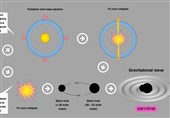Gravitational Wave Detected from Massive Merger of 2 Black Holes 7bln Years Ago
TEHRAN (Tasnim) – A long time ago and extremely far, far away, two black holes merged.
An international collaboration of scientists on Wednesday announced the merger of two black holes, detected by a gravitational wave generated when the universe was "about half its age."
The signal from the wave, labeled GW190521, was first detected on May 21, 2019 with the National Science Foundation's Laser Interferometer Gravitational-wave Observatory (LIGO) and the Advanced Virgo detector at the European Gravitational Observatory (EGO).
The two black holes merged to produce a new black hole of intermediate mass -- the first clear detection of its kind, researchers said. Intermediate mass puts the black hole's mass between 100 and 1,000 times that of the sun, scientists said.
EGO estimates the merger happened "about 7 billion years ago, a time close to the ancient ages of the Universe." The brief signal detected by scientists lasted less than a tenth of a second, the LIGO Scientific Collaboration (LSC) reported.
According to the LIGO Scientific Collaboration, every gravitational wave signal detected so far has been from a "binary merger," either two black holes or two neutron stars. The collaboration reports this merger "appears to be the most massive yet" and the two black holes that merged had masses "about 85 and 66 times the mass of the sun."
“This doesn’t look much like a chirp, which is what we typically detect,” says Virgo member Nelson Christensen, a researcher at the French National Centre for Scientific Research, said in a press release. “This is more like something that goes ‘bang,’ and it’s the most massive signal LIGO and Virgo have seen.”
Findings on the discovery were published in Physical Review Letters. A report in The Astrophysical Journal Letters details the signal's implications.
Black holes that have been previously observed fit into two categories.
They are either stellar-mass black holes, "which measure from a few solar masses up to tens of solar masses," the ones thought to form when massive stars die; or they are supermassive black holes, the ones that are hundreds of thousands to billions of times larger than the sun, according to the LIGO Scientific Collaboration.
“LIGO once again surprises us not just with the detection of black holes in sizes that are difficult to explain, but doing it using techniques that were not designed specifically for stellar mergers,” Pedro Marronetti, program director for gravitational physics at the National Science Foundation, said in a statement.
He added, “This is of tremendous importance since it showcases the instrument’s ability to detect signals from completely unforeseen astrophysical events. LIGO shows that it can also observe the unexpected.”
The discovery raises some questions. The larger of the two black holes that merged to create the intermediate mass black hole falls firmly into a mass range known as the "pair instability mass gap" — the LIGO Scientific Collaboration reports a collapsing star "should not be able to produce a black hole between approximately 65 and 120 solar masses."
“The fact that we’re seeing a black hole in this mass gap will make a lot of astrophysicists scratch their heads and try to figure out how these black holes were made,” said Nelson Christensen, director of the Artemis Laboratory at the Nice Observatory in France, in a statement.
Scientists are considering the possibility the two black holes that formed to create the intermediate mass black hole first themselves formed from mergers of smaller black holes.
There's still the possibility the gravitational wave detected was produced by something other than a merger of two black holes.
“The bar for asserting we’ve discovered something new is very high,” Alan Weinstein, professor of physics at Caltech, said in a statement. “So we typically apply Occam’s razor: The simpler solution is the better one, which in this case is a binary black hole.”






